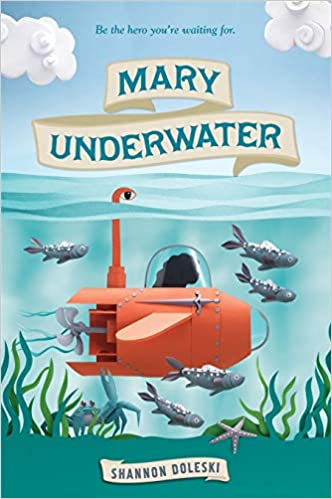When I began Shannon Doleski‘s upper-middle grade debut Mary Underwater, the sparse and powerful prose hooked me on page one. Shannon’s writing is tight. Real. Intense.
We’ll get to that in a minute because lucky me, I have the author here for an interview! But first—lucky you—one reader will win a copy of Mary Underwater. Hop to the end of this post for the Rafflecopter signup, then come back to hear what Shannon has to say about writing this wonderful story.
Deadline to enter the giveaway: Tuesday, July 21, 11:59 PM.
A. B. Westrick: Shannon, welcome to my blog!
Shannon Doleski: Thanks for inviting me!
ABW: I want to start with your writing. The book flows beautifully. Every single word belongs where it is, and my question is: are your first drafts as tightly written as the final? Tell me about your process. Do you write sparsely from the get-go and find yourself needing to add details later? Or do you tend to overwrite and on revision cut the excess?
SD: Oh my gosh! This question made my day! I do always aim for spare, clean prose. Usually my first drafts are shorter than my final. I build the bones of the story and have to go back and add more on second, third rounds to make it feel more whole. As a reader, I prefer prose that feels like each word is necessary. I am impatient and skim over unnecessary words, so I try to think of the people who skim while I’m writing. Actually, maybe my impatience rules my writing and my life. Hahahahaha.
ABW: Oh, that’s funny. Impatience, huh? Well, whatever the reason, the result is great writing. I was struck by the way your words evoked feelings in me. Part of page one says:
My dad is home, and anger has leaked back into the house… I get dressed for school as quietly as I can while a battle rages in the kitchen. I press my hands to my ears, dulling the sound. Two weeks. He’s been home for two weeks.
Brilliant. This is “show don’t tell” at its best. Without you telling me what Mary was feeling, your words made me anxious. I got worried. You brought me straight into a tense moment. The repetition of “two weeks” punched me in the gut. Was this scene always your opening? When you first sat down to begin Mary’s story, how did you start? What was your entry point?

SD: Mary heading to school for science class (and her parents arguing while she’s getting ready) was always the first scene. I was a high school and middle school teacher, and so often kids bring whatever is happening at home with them to school. I think the old first line was something lighter. Something about Joan of Arc. My editor liked the line you mention. It was a few sentences down the page initially, and she suggested we move it front and center. We also added the Joan of Arc excerpts during edits.
ABW: Oh, good call. The Joan of Arc passages add a whole new layer. I liked how Mary keeps seeking strength by comparing her situation to Joan of Arc’s. The historical interludes are great.
Now, I want to ask about the opening. Right away you pull readers into the crux of the story: Mary lives in an abusive household and struggles to keep victimhood at bay. The abuse takes place off-screen, and for a middle-grade novel, I think that’s appropriate. While writing, were you conscious that some of your readers might be as young as ten? Along the way, did you draft any scenes that were even darker than those which appear in the final, but on revision, you cut them out?
SD: I did not take out any scenes with her father. All of the dad scenes are as originally written. Initially, Mary Underwater was a YA book. She was a year older, but fourteen/fifteen year old protagonists don’t really exist in YA or MG. I knew that going into writing it, but I had just finished teaching ninth graders to be a stay-at-home parent, and I missed the age group.

Even when Mary Underwater was YA, I had the dad scenes off-screen. I didn’t want to sensationalize the abuse. I wanted all the afters to matter more. How does she feel after? How does it affect her life after? For a lot of kids, even kids younger than ten, abuse is something they are familiar with or dealing with, and I wanted them to feel seen without making it a spectacle.
ABW: Helping them feel seen—that’s so important. And it makes me wish there were a way to get your book into lots of households right now because there are so many reports of domestic violence on the rise while we’re dealing with COVID-19. My heart goes out to these kids.
Now as a contrast, you’ve got funny-guy Kip Dwyer in this story. He’s a wonderful character who brings comic relief to the intensity that surrounds everything-Mary. Did you base his personality on anyone you know? (Are any of the characters based on real people?) How do you go about developing your characters?

SD: Kip is me, hahahaha. He is an Aries and my same Myers-Briggs personality. ENTJ.
ABW: Oh, I love it. That’s great. (We have an ENTJ in my family, so I know the type well!)
SD: Kip is also a whole bunch of eighth and ninth grade boys I taught and coached. In one scene, Mary remembers how he put noisy Halloween decorations in the teacher’s ceiling panels, and that is a real thing that happened to me as a first year teacher by a pair of twins with freckles.
In this book, I needed someone who was both relentlessly upbeat to counter Mary and also going through his own parent stuff so Mary felt comfortable confiding in him.
As a teacher, another fascinating thing I noticed was that I had these class clown boys in love with the quiet girls for years. It seemed to happen every year, and I loved it.
ABW: That’s a fun observation. Class clowns and quiet types. Maybe they balance each other out.
Now let’s talk pacing and structure. The story’s pacing is great. You build to a climactic moment that feels necessary. Do you outline first? (Are you a plotter or a seat-of-your-pantser?)
SD: I think I’m a mix of both. Mary Underwater is the first book I ever wrote, and the plot structure is much different in the final version. The scenes are the same, just in a different order. I owe that to my editor. She’s amazing! We condensed and moved scenes until the story had that climatic moment. I was constantly blown away by how her notes made it so much better.
The more I write, the better I get at trying to hit plot beats, but it’s definitely the part I have to work on the most.
ABW: I hear you. Novels really come together during the revision process.
Finally, your bio mentions the Air Force, and I just have to ask which base you’ve liked most, out of all the places you’ve lived? I’m asking for personal reasons! My son is early in his USAF career, currently training in North Carolina. (Occasionally he has been heard to say, “Go Strike Eagles!”)

SD: This is tough because I like each place we’ve lived for different reasons. I get nostalgic for them constantly. Mary Underwater is my love letter to the Chesapeake Bay while we lived there. We’ve also been stationed outside of DC, Boston, Denver, and now West Texas. I take little pieces of each place with me, wherever we go, and I write stories that reflect their different personalities. My favorite part of military life is learning about the different places in this world and meeting people. And congrats to your son!
ABW: Thank you. He’s loved it so far. (And through him, I’ve learned a lot about the air force.) Okay, last question. What are you working on now?
SD: I just turned in a post-apocalyptic upper middle-grade! It’s set in Maine and very lush and green and hopeful. Maybe soon I will be able to shout about it more!
ABW: Ooooh, I look forward to reading it!
Readers who want to know more about Shannon can find her at her website and on Twitter, Instagram and Facebook. If you visit any of these sites, be sure to say so in the Rafflecopter below! You can enter every day until the deadline: Tuesday, July 21, 2020, at 11:59 PM.
a Rafflecopter giveaway

I’m happy to see more MG fiction. These topics need exploring. What does a child do when he/she feels trapped in secrets and fears even more will come. Sounds like the writer has written a much-needed book! Thanks for the interview.
Agreed. A much-needed book and exceptionally well written.
This sounds like a great book, especially now. It means a lot to kids going through similar things to know they’re not alone.
Yes, especially now when a lot of people are feeling very much alone. When school is your safe haven and schools are closed… ugh. I hurt for families who are hurting.